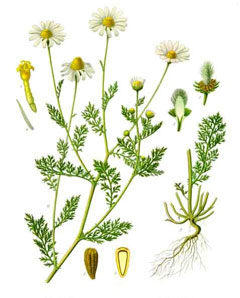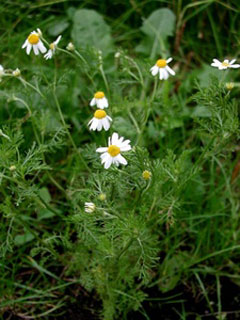 |
|
http://commons.wikimedia.org/wiki/File:Koeh-160.jpg |
 |
| http://www.biopix.com/ |
Translate this page:
Summary
A strong odored flowering annual with some edible, medicinal and other uses. Easily confused with A. arvensis but it's strong smell gives it away. Common Names include: mayweed chamomile; stinking chamomile; stinking mayweed. Spanish: camomilla pudenta; manzanilla hedionda; manzanillon.
French: anthemis fetide; camomille des chiens; camomille maroute; camomille puante; maroute puante. Portuguese: macela-fetida. Germany: Stinkende Hundskamille. Italy: camomilla cotula; camomilla mezzana. Japan: kamitsuremodoki. Netherlands: stinkende kamille. Sweden: kamomillkulla; surkulla.
Physical Characteristics

 Anthemis cotula is a ANNUAL growing to 0.6 m (2ft) by 0.3 m (1ft in).
Anthemis cotula is a ANNUAL growing to 0.6 m (2ft) by 0.3 m (1ft in).
See above for USDA hardiness. It is hardy to UK zone 5 and is not frost tender. It is in flower from July to September. The species is hermaphrodite (has both male and female organs) and is pollinated by Flies, beetles. The plant is self-fertile.
Suitable for: medium (loamy) and heavy (clay) soils and can grow in heavy clay soil. Suitable pH: mildly acid, neutral and basic (mildly alkaline) soils. It cannot grow in the shade. It prefers dry or moist soil.
UK Hardiness Map
US Hardiness Map
Synonyms
Plant Habitats
Cultivated Beds;
Edible Uses
Edible Parts: Leaves
Edible Uses: Tea
The herb is used as a flavouring in Peru[183]. It is aromatic. Caution is advised, there are some reports of toxicity. A herb tea is made from the flowers in a similar way to camomile tea[183] and it has a similar though weaker effect medicinally[4]. The odour is not very pleasant and so it is not commonly used[4].
References More on Edible Uses
Medicinal Uses
Plants For A Future can not take any responsibility for any adverse effects from the use of plants. Always seek advice from a professional before using a plant medicinally.
Antispasmodic Astringent Diaphoretic Diuretic Emetic Emmenagogue Epilepsy Stings
Tonic
Mayweed is closely related to camomile, but is far less effective as a medicine[254]. It has been used as an antispasmodic and to induce menstruation and was traditionally used to treat supposedly hysterical conditions related to the uterus[254]. It is rarely used in contemporary herbal medicine[254]. The whole plant is antispasmodic, astringent, diaphoretic, diuretic, emetic, emmenagogue and tonic[4, 61]. It is used internally as a tea, which can be made either from the flowers or the whole plant, though the flowers are less unpleasant and so are more commonly used[4]. An infusion is used in the treatment of a variety of complaints such as rheumatism, epilepsy, asthma, colds and fevers[257]. Applied externally, it is used as a poultice on piles or to draw splinters out of the body, and can also be applied to the bath water[4, 257]. The leaves are rubbed onto insect stings[222]. Some people are allergic to the plant and this remedy could give them painful blisters[240]. This herb is contraindicated for pregnant women or nursing mothers[254].
References More on Medicinal Uses
The Bookshop: Edible Plant Books
Our Latest books on Perennial Plants For Food Forests and Permaculture Gardens in paperback or digital formats.

Edible Tropical Plants
Food Forest Plants for Hotter Conditions: 250+ Plants For Tropical Food Forests & Permaculture Gardens.
More

Edible Temperate Plants
Plants for Your Food Forest: 500 Plants for Temperate Food Forests & Permaculture Gardens.
More

More Books
PFAF have eight books available in paperback and digital formats. Browse the shop for more information.
Shop Now
Other Uses
Dye Repellent
The growing and the dried plant is said to repel mice and fleas[4, 20], it can also be used as an insecticide[21, 61, 100]. A gold dye is obtained from the whole plant[168, 169].
Special Uses
Scented Plants
References More on Other Uses
Cultivation details
Prefers a sunny position and a well-drained soil that is neutral to slightly acid[1, 200]. Succeeds in heavy clay soils. Bees dislike this plant[4]. The leaves contain glands which release a most disagreeable odour when the plant is handled and can cause allergic reactions in people.
References Carbon Farming Information and Carbon Sequestration Information
Temperature Converter
Type a value in the Celsius field to convert the value to Fahrenheit:
Fahrenheit:
The PFAF Bookshop
Plants For A Future have a number of books available in paperback and digital form. Book titles include Edible Plants, Edible Perennials, Edible Trees,Edible Shrubs, Woodland Gardening, and Temperate Food Forest Plants. Our new book is Food Forest Plants For Hotter Conditions (Tropical and Sub-Tropical).
Shop Now
Plant Propagation
Seed - best sown outdoors as soon as it is ripe. Most of the seed germinates in the autumn.
Other Names
If available other names are mentioned here
Native Range
TEMPERATE ASIA: Saudi Arabia, Cyprus, Iran (north), Iraq (north), Israel, Jordan, Lebanon, Syria, Turkey, Russian Federation-Ciscaucasia (Ciscaucasia), Armenia, Azerbaijan, Georgia, Russian Federation (Dagestan) TROPICAL ASIA: India (Himachal Pradesh, Jammu and Kashmir, Uttar Pradesh) EUROPE: Denmark, United Kingdom (England), Norway (south), Sweden (south), Austria, Belgium, Switzerland, Czech Republic, Germany, Hungary, Netherlands, Poland, Slovakia, Belarus, Moldova, Ukraine (incl. Krym), Albania, Bulgaria, Bosnia and Herzegovina, Greece (incl. Crete), Croatia, Italy (incl. Sardinia, Sicily), North Macedonia, Montenegro, Romania, Serbia, Slovenia, Spain (incl. Baleares), France (incl. Corsica), Portugal AFRICA: Algeria (north), Egypt (north), Libya (north), Morocco, Tunisia
Weed Potential
Right plant wrong place. We are currently updating this section.
Please note that a plant may be invasive in one area but may not in your area so it's worth checking.
Not very invasive, but aggressive growth particularly in wet, poorly-drained environments. It reduces the yield and quality of harvested crops, particularly of broadleaf crops.
Conservation Status
IUCN Red List of Threatened Plants Status : This taxon has not yet been assessed.

Growth: S = slow M = medium F = fast. Soil: L = light (sandy) M = medium H = heavy (clay). pH: A = acid N = neutral B = basic (alkaline). Shade: F = full shade S = semi-shade N = no shade. Moisture: D = dry M = Moist We = wet Wa = water.
Now available:
Food Forest Plants for Mediterranean Conditions
350+ Perennial Plants For Mediterranean and Drier Food Forests and Permaculture Gardens.
[Paperback and eBook]
This is the third in Plants For A Future's series of plant guides for food forests tailored to
specific climate zones. Following volumes on temperate and tropical ecosystems, this book focuses
on species suited to Mediterranean conditions—regions with hot, dry summers and cool, wet winters,
often facing the added challenge of climate change.
Read More
Expert comment
Author
L.
Botanical References
17200
Links / References
For a list of references used on this page please go here
Readers comment
| Add a comment |
|
If you have important information about this plant that may help other users please add a comment or link below. Only comments or links that are felt to be directly relevant to a plant will be included. If you think a comment/link or information contained on this page is inaccurate or misleading we would welcome your feedback at [email protected]. If you have questions about a plant please use the Forum on this website as we do not have the resources to answer questions ourselves.
* Please note: the comments by website users are not necessarily those held by PFAF and may give misleading or inaccurate information.
To leave a comment please Register or login here All comments need to be approved so will not appear immediately.
|
Subject : Anthemis cotula
|
|
|
|